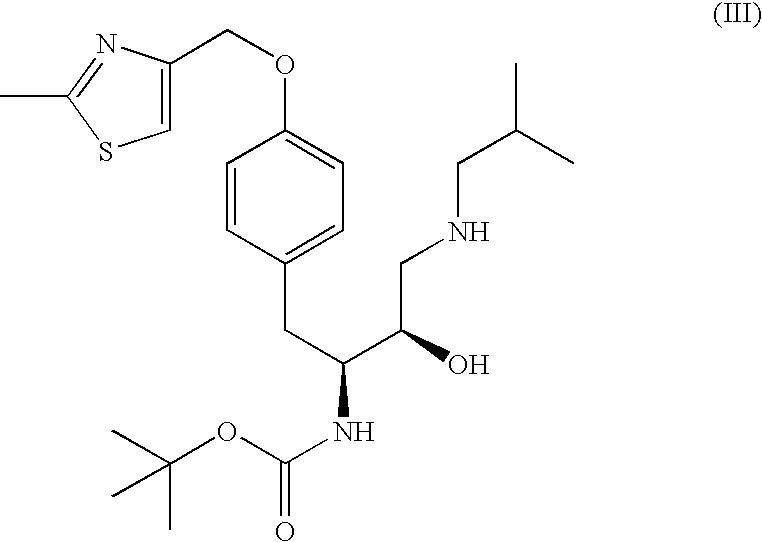Preparation of chemical compounds
a chemical compound and compound technology, applied in the field of preparation of chemical compounds, can solve the problems of difficult preparation in a cost-effective and efficient manner, unsuitable large-scale manufacturing processes, and chemical complexity of drugs used as protease inhibitors
- Summary
- Abstract
- Description
- Claims
- Application Information
AI Technical Summary
Benefits of technology
Problems solved by technology
Method used
Image
Examples
example 1
Preparation of tert-butyl (1S,2R)-3-[(1,3-benzodioxol-5-ylsulfonyl(isobutyl)amino]-2-hydroxy-1-{4-[(2-methyl-1,3-thiazol-4-yl)methoxy]benzyl}propylcarbamate
[0081]
[0082] A reaction vessel was charged with tert-butyl (1S)-2-{4-[(2-methyl-1,3-thiazol-4-yl)methoxy]phenyl}-1-[(2S)-oxiran-2-yl]ethylcarbamate (1.0 wt.) followed by acetonitrile (3.5 vol.), methanol (1.0 vol.), and isobutylamine (8.3 equiv., 2.1 vol.). The resulting mixture was heated to reflux and held at reflux for 3 h. Acetonitrile (9.0 vol.) was charged and distillate (9.0 vol., 6.8 wt.) was collected at atmospheric pressure. A second portion of acetonitrile (9.0 vol.) was charged and distillate (9.0 vol., 6.9 wt.) was collected at atmospheric pressure. Acetonitrile (2.5 vol.) was charged and the reaction mixture was cooled to ˜25° C. A solution of 1,3-benzodioxole-5-sulfonyl chloride (1.1 equiv., 0.62 wt) in acetonitrile (2 vol.) was charged while maintaining a temperature of ˜25° C. A solution of sodium bicarbonate (1...
example 2
Preparation of N-(3R, 3aS, 6aR)-hexahydrofuro[2,3-b]furan-3-yl-oxycarbonyl-(4S,5R)-4-[4-(2-methylthiazolo-4-meth loxy)-benzyl]-5-1-butyl-[(3,4-methylenedioxyphenyl)sulfonyl]-aminomethyl-2,2-dimethyl-oxazolidine
[0083]
A reaction vessel was charged with tert-butyl (1S,2R)-3-[(1,3-benzodioxol-S-ylsulfonyl)(isobutyl)amino]-2-hydroxy-1-{4-[(2-methyl-1,3-thiazol-4-yl)methoxy]benzyl}propylcarbamate (1.0 wt.), tetrahydrofuran (5.0 vol.), and water (0.05 vol.) and stirred at ˜25° C. The reaction vessel was then charged with methane sulfonic acid (3.0 equiv., 0.30 vol.), and the resulting mixture was heated over 30 min to ˜50° C., stirred, and then heated over 30 min to reflux. Water (0.25 vol.) was added, the reaction mixture was cooled to ˜50° C., and triethylamine (3.7 equiv., 0.80 vol.) was added followed by solid (3R,3aS,6aR)-hexahydrofuro[2,3-b]furan-3-yl 4-nitrophenyl carbonate. (1.05 equiv., 0.48 wt.). The resulting mixture was brought to reflux, and stirred for 3.5 h. The reaction m...
example 3
Preparation of ethyl 4,5-dihydrofaran-3-yl(oxo)acetate
[0084]
[0085] A flask was charged with 2,3-dihydrofuran (0.77 wt, 1.5 eq.), triethylamine (0.82 wt, 1.1 eq.) and MTBE (4 vol). To this solution at room temperature was added ethyl chlorooxoacetate (1 wt., 1 eq.) dropwise. During the addition the temperature rose and was kept below 35° C. by external cooling (total addition time 1 h). After the addition, the reaction was allowed to cool to room temperature, and stirred for 2 h. The reaction mixture was washed with water (3×2 vol.). The organic layer was concentrated at 30° C. to afford ethyl 4,5-dihydrofuran-3-yl(oxo)acetate as an oil (76-89%).
PUM
| Property | Measurement | Unit |
|---|---|---|
| Electrical conductance | aaaaa | aaaaa |
| Electrical conductance | aaaaa | aaaaa |
Abstract
Description
Claims
Application Information
 Login to View More
Login to View More - Generate Ideas
- Intellectual Property
- Life Sciences
- Materials
- Tech Scout
- Unparalleled Data Quality
- Higher Quality Content
- 60% Fewer Hallucinations
Browse by: Latest US Patents, China's latest patents, Technical Efficacy Thesaurus, Application Domain, Technology Topic, Popular Technical Reports.
© 2025 PatSnap. All rights reserved.Legal|Privacy policy|Modern Slavery Act Transparency Statement|Sitemap|About US| Contact US: help@patsnap.com



